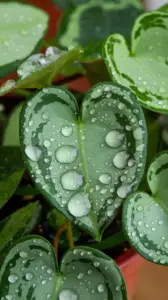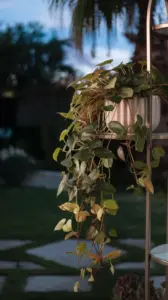Biological Features of Red Roses
The Red Roses, known scientifically as Rosa rubiginosa, boasts numerous biological features that contribute to its popularity. This plant exhibits a beautiful array of vibrant red petals. These petals are often velvety and fragrant. Its growth typically occurs on thorny stems, which add to its character.
Structure and Anatomy
The structure of the Red Rose includes various components. The roots anchor the plant, absorbing nutrients and water. The stems support the flowers, showcasing their beauty. Meanwhile, the leaves are oval-shaped with a serrated edge, enhancing photosynthesis.
Reproductive Features
Red Roses reproduce through both sexual and asexual means. Typically, they produce seeds, although many gardeners prefer cuttings for propagation. Each flower contains both male (stamens) and female (pistils) reproductive parts. This facilitates self-pollination and cross-pollination.
Adaptation Characteristics
Moreover, Red Roses exhibit adaptability to various environments. They thrive in well-drained soils and require full sunlight for optimal growth. These plants can face challenges like pests and diseases but possess natural resistance.
| Feature | Description |
|---|---|
| Petal Color | Vibrant Red |
| Leaf Shape | Oval with Serrated Edges |
| Growth Type | Thorny Stem |
| Reproductive Method | Seeds and Cuttings |
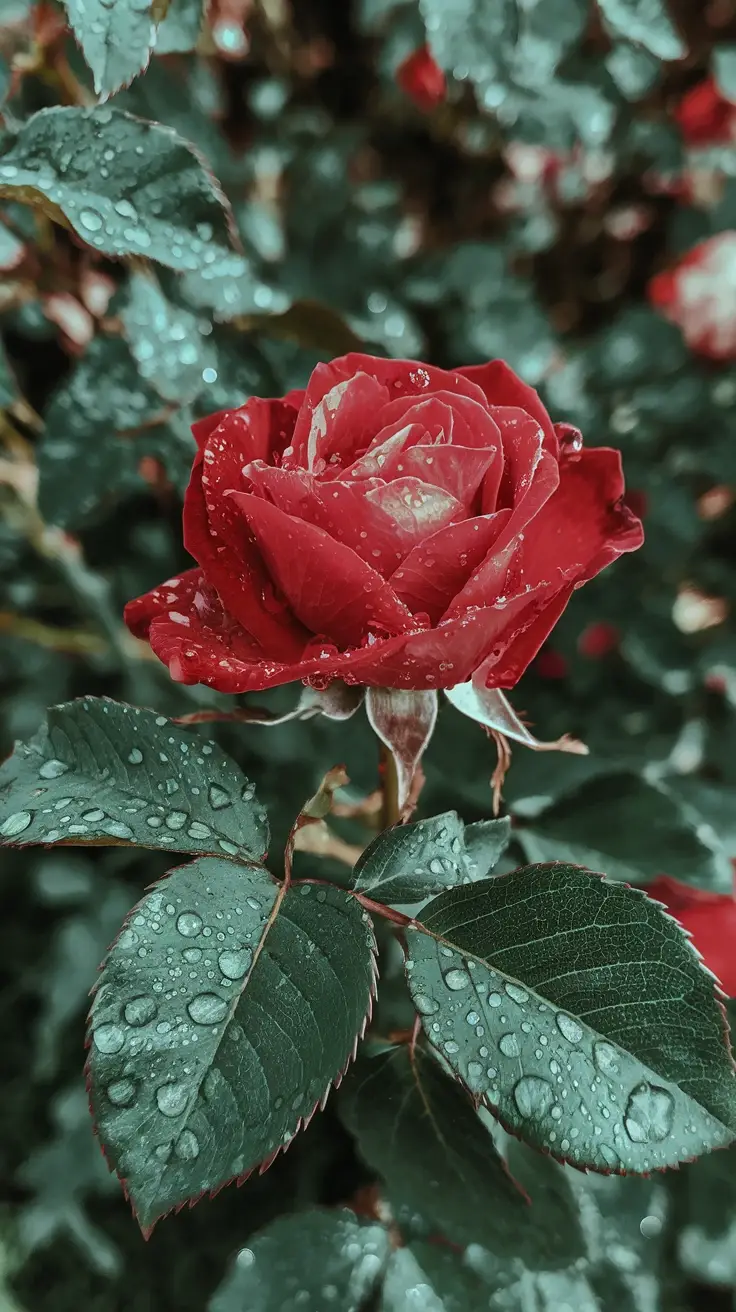
History and Cultural Significance
The Red Rose has a rich history that spans centuries and cultures. Often symbolizing love and passion, it is a powerful representation of human emotions. Throughout history, this flower has been revered in literature, art, and folklore. For instance, ancient civilizations cultivated roses for their beauty and fragrance.
In the medieval era, red roses became a symbol of the Tudor dynasty in England. The famous Wars of the Roses featured the red rose as the emblem of the House of Lancaster. Consequently, it reflects the intricate tapestry of British history.
Moreover, the Red Rose holds significant cultural importance in various societies. In many countries, it is a traditional gift during romantic occasions, such as anniversaries and Valentine’s Day. Its deep color and delicate petals express feelings that words often cannot convey. As a result, love letters frequently include the imagery of red roses.
- In literature, red roses symbolize passionate love. They often appear in romantic poetry.
- In art, they are frequently depicted in various forms, showcasing their beauty.
- In many cultures, red roses are a staple in wedding arrangements, signifying deep commitment.
- The Red Rose is also the national flower of the United States, representing beauty and love.
Beyond the symbolic meanings, the cultivation of red roses has evolved over the years. Hybridization and selective breeding have led to diverse varieties, each with unique traits. Some varieties boast larger blooms, while others exhibit remarkable fragrances. Consequently, gardeners and florists cherish these attributes when selecting red roses for arrangements.
In summary, the Red Rose is not just a flower; it is a cultural icon with profound significance across the globe. Its history intertwines with human emotion, making it a timeless representation of love.
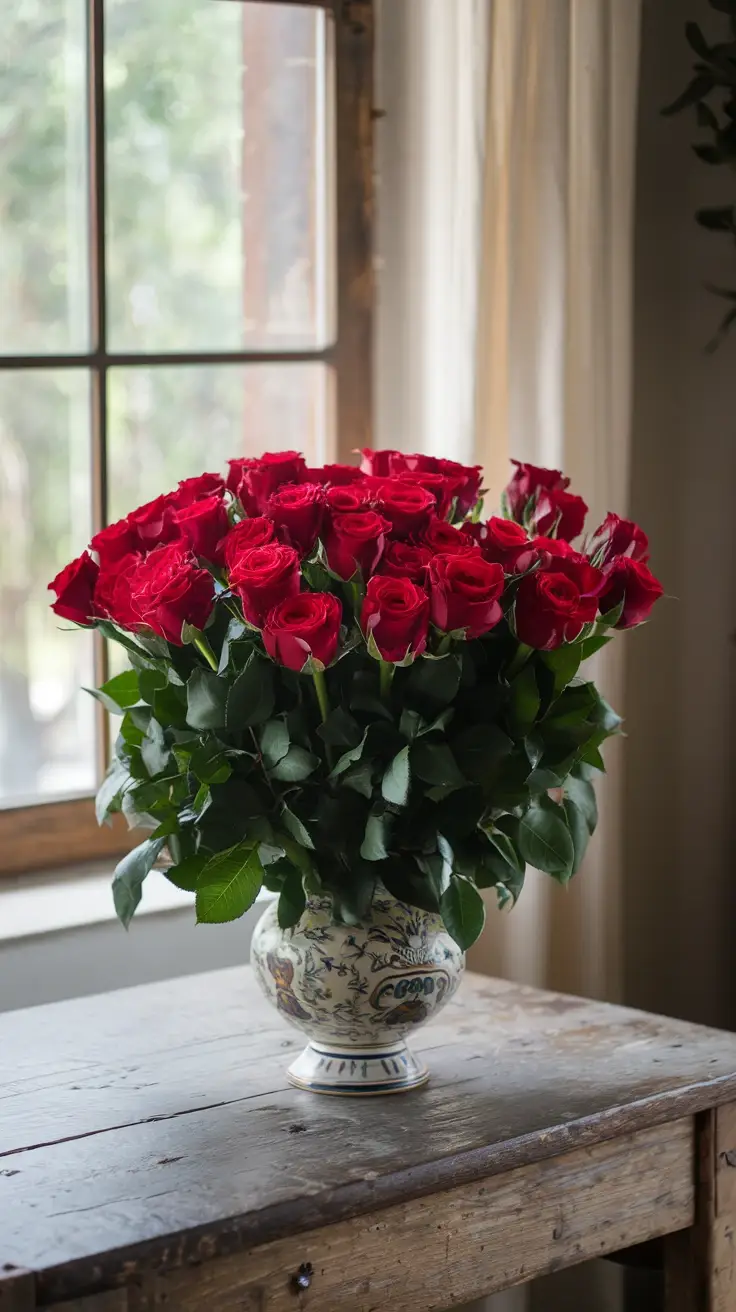
Ideal Growing Conditions for Red Rose
Red Roses thrive best in environments that mimic their native habitats. Understanding these ideal conditions can significantly enhance their growth and overall health. To start with, Red Roses prefer full sun exposure. They need at least six to eight hours of sunlight daily. This ample sunlight promotes lush foliage and abundant blooms.
Soil quality plays an essential role as well. Red Roses thrive in well-draining soil rich in organic matter. A slightly acidic to neutral pH, around 6.0 to 6.8, is optimal. Regularly amending the soil with compost will provide necessary nutrients and improve soil structure.
Watering Needs
Watering is crucial for the health of Red Roses. They require deep watering at least once a week. This approach encourages strong root development. However, it’s essential to avoid waterlogging. Overly saturated soil can lead to root rot, which can harm the plant.
Temperature and Humidity
Red Roses flourish in moderate temperatures, ideally between 60°F to 75°F. Extreme temperatures can stress the plants. Therefore, during unusually hot weather, provide some afternoon shade. This practice will help prevent wilting and sunburn.
Moreover, Red Roses appreciate moderate humidity levels. If you live in a dry climate, consider misting your plants or using a humidity tray. This increased humidity benefits Red Roses, especially during their growing season.
Fertilization
Feeding Red Roses properly enhances their growth. A balanced fertilizer, high in phosphorus, promotes blooming. Apply fertilizer every 4-6 weeks during the growing season. It’s vital to follow the manufacturer’s recommended application rates.
Pest and Disease Management
Lastly, be vigilant for pests. Aphids and spider mites are common threats. Regularly inspect your plants for signs of infestation. Early intervention can save your Red Roses from serious damage.
| Factor | Ideal Condition |
|---|---|
| Sun Exposure | 6-8 hours of sunlight |
| Soil Type | Well-draining, rich in organic matter |
| pH Level | 6.0 – 6.8 |
| Watering Frequency | Once a week, deep watering |
| Optimal Temperature | 60°F – 75°F |
| Humidity Level | Moderate |
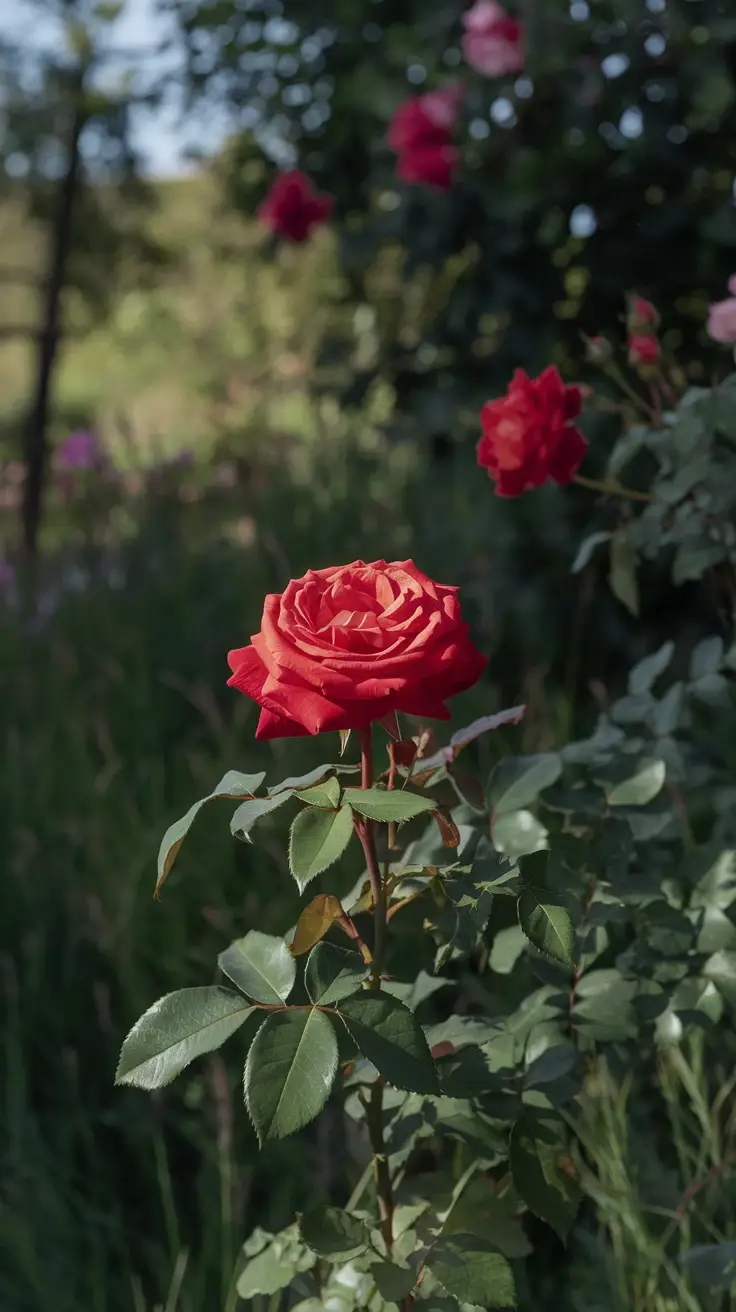
Plant Care and Maintenance
Taking care of a Red Rose requires attention to various factors such as sunlight, water, soil, and fertilization. Proper maintenance ensures beautiful blooms and healthy growth. Here are some essential care tips for your Red Rose.
Sunlight Requirements
Red Roses thrive best in full sun. Aim for at least 6-8 hours of direct sunlight daily. However, too much intense afternoon sun can scorch the leaves. Position your roses in a location that receives morning sun and some afternoon shade.
Watering Guidelines
Watering is crucial for keeping your Red Roses vibrant. Ensure the soil remains consistently moist, but avoid waterlogging. It’s essential to water deeply and infrequently. This encourages root development.
- Water early in the morning to reduce evaporation.
- Use mulch to retain soil moisture.
- Consider a drip irrigation system for efficiency.
Soil Conditions
Red Roses prefer well-draining soil that is rich in organic matter. A pH level between 6.0 and 6.8 is ideal. To improve soil quality, mix in compost or well-rotted manure before planting.
Fertilization Practices
Regular fertilization boosts the health of your Red Rose. Use a balanced fertilizer every 4-6 weeks during the growing season.
- Choose a fertilizer with a high phosphorus content for blooming.
- Follow the manufacturer’s instructions to prevent over-fertilization.
- Consider organic options like fish emulsion or bone meal for a natural boost.
Pruning Techniques
Pruning is necessary to promote growth and remove dead or diseased wood. Typically, prune your Red Roses in late winter or early spring, before new growth appears. This helps maintain the plant’s shape and encourages airflow.
- Remove dead wood and spent blooms regularly.
- Aim to shape the rose bush while maintaining its natural form.
- Be sure to use clean, sharp tools to prevent damage.
Pest and Disease Management
Watch out for common pests like aphids and spider mites. Also, diseases like black spot affect Red Roses. Regularly inspect your plants and act promptly if you notice any issues.
- Use neem oil or insecticidal soap for pest control.
- Ensure good air circulation to minimize diseases.
- Practice crop rotation to reduce the chance of soilborne diseases.
By following these care and maintenance tips for your Red Rose, you’ll enjoy a flourishing display in your garden.

Propagation Techniques for Red Rose
Propagation is a crucial process for cultivating beautiful Red Roses. There are several effective methods to propagate them. Each method requires attention and care to achieve healthy new plants.
Methods of Propagation
The most common techniques include cuttings, layering, and seed propagation. Among these, cuttings are the easiest and most popular way to propagate Red Roses. This method typically involves selecting a healthy stem and cutting it just below a leaf node.
To enhance success rates, dip the cut end in rooting hormone. Then, place the cutting in a moistened potting mix. Ensure that the cutting has sufficient light but avoid direct sunlight to prevent wilting. Keeping the soil consistently moist will support root development.
Layering is another effective way to propagate Red Roses. This method involves bending a stem to the ground and covering a portion with soil while keeping the end exposed. In this case, roots will develop at the buried part over time. Once roots form, the new plant can be severed and transplanted.
Lastly, seed propagation allows gardeners to start Red Roses from seeds. However, this method usually takes longer and requires patience. Soak seeds in water for a day before planting them in seed trays. Use a seed-starting mix, keeping it moist to promote germination. It often takes several weeks to see seedlings appear.
Regardless of the method chosen, carefully monitor the new plants. They need proper lighting and moisture. Moreover, providing nutrients as they grow will encourage healthy development.
In summary, propagating Red Roses can be accomplished using various techniques. Cuttings, layering, and seed propagation each have their unique benefits. With proper care and attention, you’ll enjoy beautiful blooms in no time.
Common Problems and Solutions
Red Rose plants can experience various issues that affect their health and beauty. Recognizing these problems early is essential for effective management. Below are some of the most common issues and their solutions.
Common Problems
- Overwatering: Excess water can lead to root rot.
- Pests: Aphids and spider mites can damage leaves.
- Fungal infections: Powdery mildew and black spot are typical fungal issues.
- Leaf drop: This can be a sign of environmental stress.
- Yellowing leaves: A common indicator of nutrient deficiency.
Solutions to Problems
Here are solutions specifically targeted for these common problems.
- For overwatering, ensure the pot has drainage holes. Only water when the top inch of soil is dry.
- To combat pests, use insecticidal soap or neem oil to treat infested leaves.
- For fungal infections, improve air circulation and apply a fungicide as soon as symptoms are noticed.
- If the plant is experiencing leaf drop, check for changes in temperature or light that might be stressing it.
- For yellowing leaves, test soil pH and consider a balanced fertilizer to restore nutrients.
Preventive Measures
Taking proactive steps can help prevent these problems from occurring. Here are some preventive measures:
- Keep your Red Rose in an area with sufficient sunlight.
- Regularly inspect the plant for any signs of pests or diseases.
- Avoid crowded conditions that restrict airflow around the plant.
Useful Reference Table
| Problem | Symptoms | Solution |
|---|---|---|
| Overwatering | Wilting, yellowing leaves | Reduce watering frequency |
| Pests | Sticky residue, visible bugs | Apply neem oil |
| Fungal infections | White spots, black edges on leaves | Apply fungicide |
| Leaf drop | Falling leaves, stunted growth | Adjust light and temperature |
| Yellowing leaves | Chlorosis, weak growth | Test pH, fertilize |
Seasonal Care Adjustments
Red Roses require different care throughout the seasons. During spring, focus on fertilization and watering. In summer, increase watering frequency to prevent wilting. Transitioning into fall, begin to reduce water gradually. Lastly, in winter, protect the plants from harsh frost. Here are essential care tips for each season:
- Spring: Fertilize with a balanced rose food.
- Summer: Water deeply twice a week.
- Fall: Gradually cut back on watering.
- Winter: Mulch heavily for insulation.
Additionally, consider the following adjustments:
- Monitor for pests in warm months.
- Prune spent blooms to encourage new growth.
- Ensure proper sunlight in winter.
By following these guidelines, your Red Roses will thrive throughout the year.
Microclimate Setup Tips
Creating the right microclimate for your Red Rose is essential for its growth and blooming. Roses thrive in specific conditions that promote health and vitality. Here are some tips to ensure your Red Rose flourishes.
- Location: Choose a spot that receives at least 6 hours of sunlight daily. Morning sun is particularly beneficial for drying dew.
- Soil Quality: Use well-draining soil rich in organic matter. A pH level between 6.0 and 6.8 is ideal.
- Watering: Water deeply but infrequently. Ensure the soil dries out slightly between watering sessions to encourage root growth.
- Fertilization: Apply a balanced fertilizer in early spring. Use a slow-release formula for sustained nutrients.
- Wind Protection: Shield your Red Rose from harsh winds. Consider a natural barrier like a hedge or fence to block gusts.
- Mulching: Apply mulch around the base to retain moisture and regulate soil temperature. This also minimizes weed growth.
By following these setup tips, your Red Rose will have the best chance to thrive and produce stunning blooms. Additionally, monitor temperature and humidity levels regularly to ensure your plant remains healthy.
Frequently Asked Questions
The Red Rose is a popular choice among gardeners. Many people wonder about its care and maintenance. Let’s address some common questions. Red Roses thrive in well-drained soil. It is essential to water them regularly but avoid overwatering.
Another common concern is sunlight. Red Roses need at least six hours of direct sunlight daily. This helps promote healthy growth and vibrant blooms. Additionally, pests can be a challenge. Regularly inspecting your plants can help catch any infestations early.
Fertilization is also important for Red Roses. Using a balanced fertilizer can enhance blooming and overall plant health. Most gardeners choose to fertilize every four to six weeks during the growing season. Lastly, pruning is crucial. Proper pruning encourages new growth and blooming.
To summarize, caring for your Red Rose requires attention to sunlight, water, and soil conditions. With the right care, these beautiful flowers will flourish, bringing joy to your garden.
Summary and Recommendations
The Red Rose is beloved for its beauty and fragrance. This iconic flower symbolizes love and passion, making it a popular choice for gardens and floral arrangements. To thrive, the Red Rose requires full sunlight and well-draining soil. Regular watering is essential but avoid waterlogging. Pruning during the growing season enhances blooms and encourages healthy growth.
When choosing varieties, consider disease resistance and climate adaptability. Furthermore, pairing with complementary plants can enhance the garden’s aesthetics. For maintenance, applying organic mulch helps retain moisture and suppress weeds. Lastly, observe the plant regularly for signs of pests or nutrient deficiencies.




